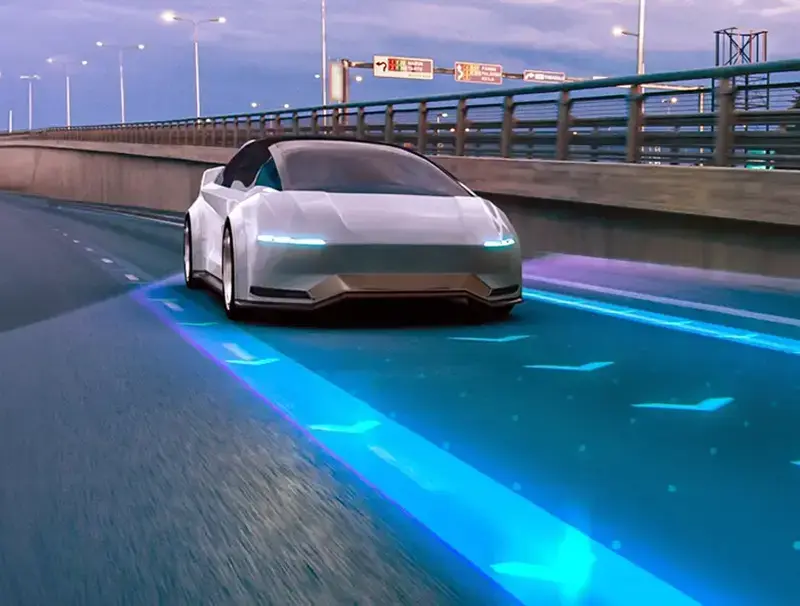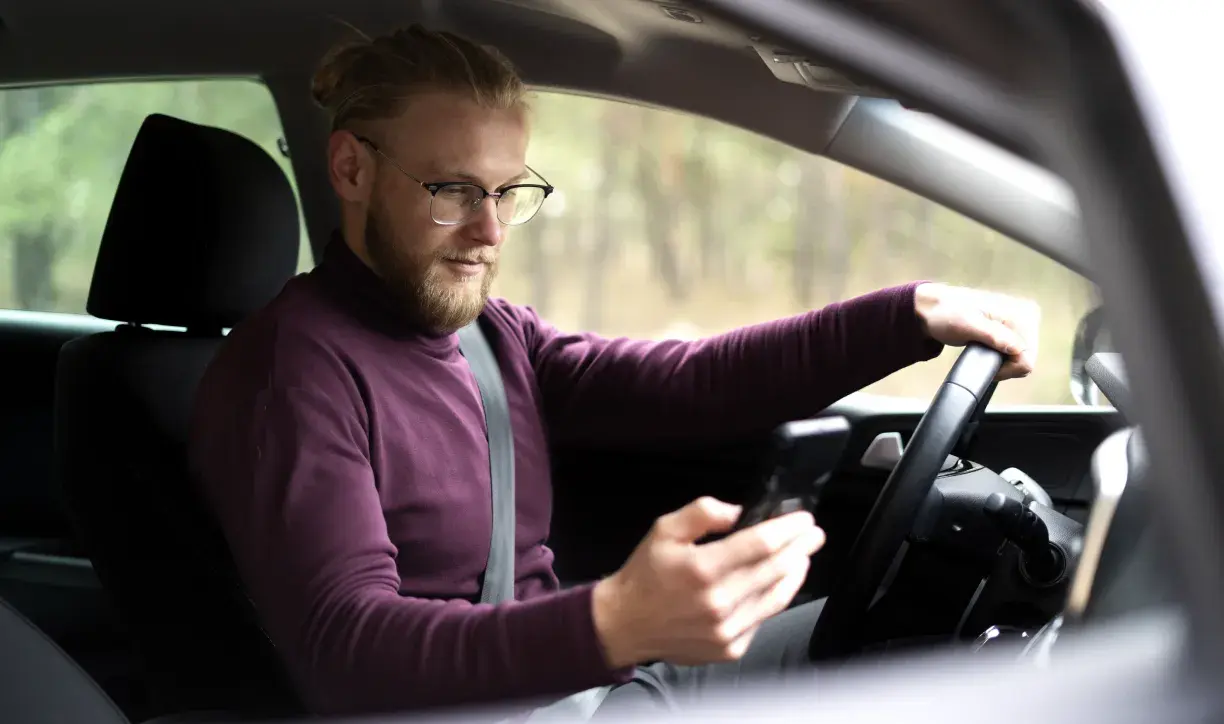Connected Cars
Connected cars are revolutionising the automotive industry, offering a glimpse into the future of driving. By integrating advanced technologies like real-time communication, autonomous features and smart vehicle systems, connected cars enhance road safety, convenience and efficiency. These innovative vehicles transform the driving experience, making it smarter and more connected.

What are connected cars?
A connected car is always synced to the internet, enabling drivers to access vehicle communication systems and other online systems, such as over-the-air software updates, GPS and other external apps connected to the car's centre console.
Connected cars allow drivers to share data with devices inside and outside the vehicle. This is achieved through mobile data networks, facilitating services remotely accessed via smartphones or other devices. All these services are tied to a central data management system.
Data transmission is a crucial feature of connected vehicles. It relies on various connected communication systems native to or adopted from aftermarket technologies. Most of the time, data transmission is bidirectional, where cars can send and receive data from systems outside the vehicles.
How do connected cars work?
The central technology behind a connected car involves either an embedded system, a tethered system or a combination of both.
In an embedded system, the car comes equipped with a pre-installed chipset and antenna, making it internet-ready when it leaves the assembly line. This system allows the car to independently download updates, send remotely accessible data and use built-in Wi-Fi to connect with other devices.
On the other hand, a tethered system relies on the user's smartphone to provide internet connectivity to the vehicle. While not as integrated as the embedded system, a tethered approach allows connectivity that enhances vehicle functionality.
Regardless of the system employed, connected vehicles can access and generate telematics data, offer remote vehicle functions and integrate with the growing ecosystem of smart devices, including electric vehicles (EVs).
How do connected cars communicate?
The purpose of connected cars isn't just about getting on the internet. They also aim to enable different forms of communication that create an interactive network on the road. These networks significantly enhance road safety and driving experience.
There are several different ways that vehicle data is transmitted:
Vehicle-to-Vehicle (V2V)
V2V communication shares real-time safety data between nearby vehicles. It exchanges information like speed, direction, steering and braking, increasing awareness of road conditions and potential hazards.
Vehicle-to-Pedestrian (V2P)
Through advanced sensor technology, V2P communication alerts drivers to pedestrians' presence, allowing timely action to prevent accidents.
Vehicle-to-Infrastructure (V2I)
V2I connects cars to local infrastructure, providing drivers with up-to-date information about traffic, weather and other alerts that might impact their journey. Advanced systems can even share details about traffic light status, construction zones, bridge heights and pedestrian crossings.
Vehicle-to-Cloud (V2C)
V2C communication creates a wealth of data, including diagnostic reports, location data and Internet of Things (IoT) connectivity.
Vehicle to Everything (V2X)
V2X is an all-encompassing term that includes all types of vehicle communication.
Connected vehicles: The road ahead is wide open for innovation
Benefits of connected cars
A connected vehicle offers a range of benefits, including access to infotainment services, support for the navigation system via third-party apps, modern, advanced safety features and remote access to a range of functions.
Here are a few specific benefits of connected cars:
- Internet connectivity: Connected cars are always connected to the internet, allowing drivers to share Wi-Fi connectivity, download updates released by the manufacturer and access other online apps.
- App-to-car connectivity: Most car manufacturers provide a dedicated smartphone app that pairs with the vehicle through a wireless network, allowing drivers to remotely monitor and control their vehicles.
- Safety and security: Connected vehicles have advanced safety features, like real-time location sharing or emergency SOS calls, which create a safety net for drivers.
- Entertainment: Connected vehicles provide various pre-loaded entertainment services, allowing drivers to connect music streaming services from their phones to their cars.
- Predictive maintenance: Computer chips and sensors collect performance data, which can alert the driver of vehicle maintenance alerts. This reduces consumer costs because it allows for the collection of data and the potential adjustment of car settings to prevent wear and tear over time.
- Traffic prediction: IoT technology can help alleviate traffic burdens and predict likely congestion points before they materialise. Cars with IoT capabilities can predict and report traffic patterns, which can help drivers travel more fuel efficiently and enhance safety on the road.
Challenges of connected vehicles
While connected cars offer several benefits for drivers, there are also a few drawbacks to keep in mind, such as cybersecurity risks, data privacy and cost.
- Cybersecurity: Connected vehicles are more vulnerable to cyberattacks, which can compromise personal data, vehicle control and safety systems.
- Data privacy: Connected vehicle data, including location, driving habits and personal information, can be misused or inadequately protected, making it difficult to gain public trust in connected vehicle technology.
- Interoperability and reliability: Ensuring different systems and components from various manufacturers work seamlessly together can be challenging. Additionally, connected cars require extensive and reliable infrastructure for optimal performance.
- Regulatory standards: The lack of standardised regulations across different regions and countries complicates implementation and compliance. Additionally, it can be difficult to determine liability in accidents involving connected vehicles.
- Cost: Developing and deploying connected vehicles can be expensive for both car manufacturers and drivers.
Connected car use cases
Connected cars offer numerous use cases across industries that enhance convenience, safety, efficiency and overall driving experience.
Here are some key examples:
Insurance
Insurers lack data and intelligence on mobility behaviour, even for traditional vehicles, including simple details such as who drives the vehicles they insure. Connected car data allows insurance companies to create enhanced insurance product tailoring, assess risk profiles, track the implications of risk and protection and define insurance rates.
Fleet management & logistics
Connected car data allows fleet operators to monitor and analyse their vehicles' operations in real time. They can monitor historical data to spot inefficient or dangerous traffic patterns and plan optimal routes to save time and fuel consumption.
Retail & media/entertainment agencies
Retail outlets can benefit from connected car data to identify optimal business locations. For example, a hotel might analyse how cars move from the airport to determine the most popular routes that still provide near connectivity to other accommodations. Likewise, advertising agencies can increase their reach by identifying hotspots at certain times of the day.
Shared mobility
Connected cars enhance shared mobility access. They can be used for services like Uber and Lyft or rented on-demand and located via a mobile app.
The future of connected cars
As the era of connected automotive solutions unfolds, we'll see more collaboration between vehicle manufacturers, technology companies and chip manufacturers.
Connected vehicles are likely to be even more integrated with our digital lives. Additionally, the rise of connected vehicles is sparking the creation of new business models and opportunities. Lastly, connected vehicles represent a significant step toward fully automated vehicles. With real-time sensing and data collection, vehicles can communicate with each other, leading to fewer crashes, improved traffic flow and enhanced safety.
Connected cars promise a world where our vehicles are not just means of transportation but also intelligent partners that enhance our daily lives. As these technologies evolve, we can look forward to a safer, more efficient, and more connected road network.
Further reading
Check out these resources to learn more about connected cars and its role in people-centric innovation.

